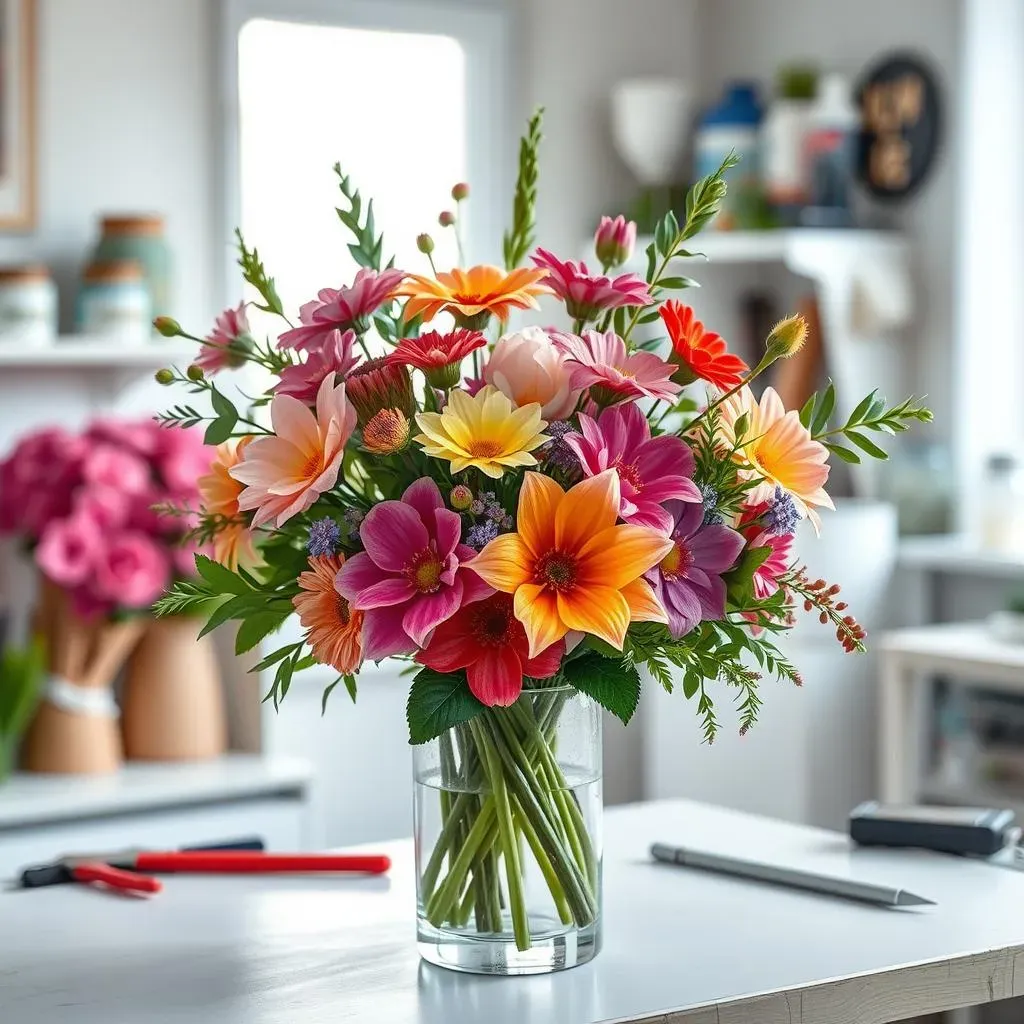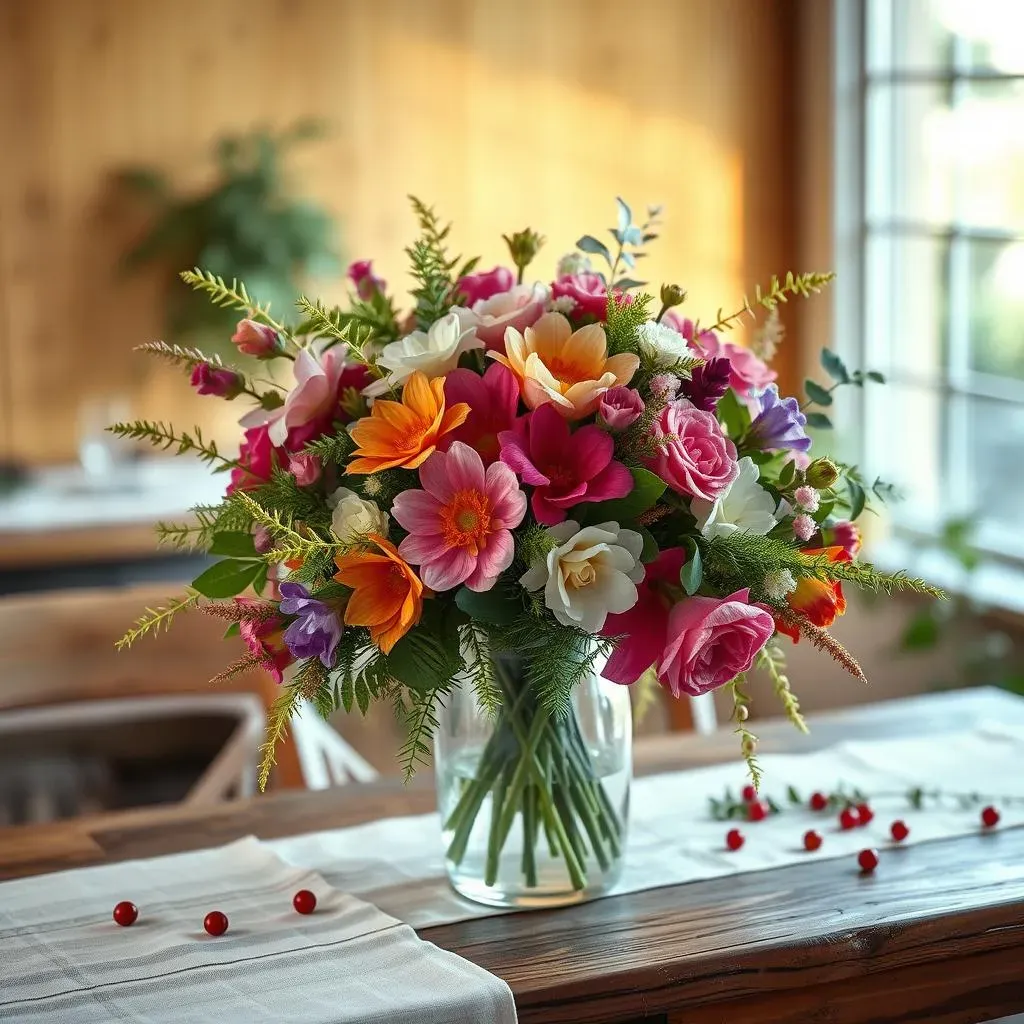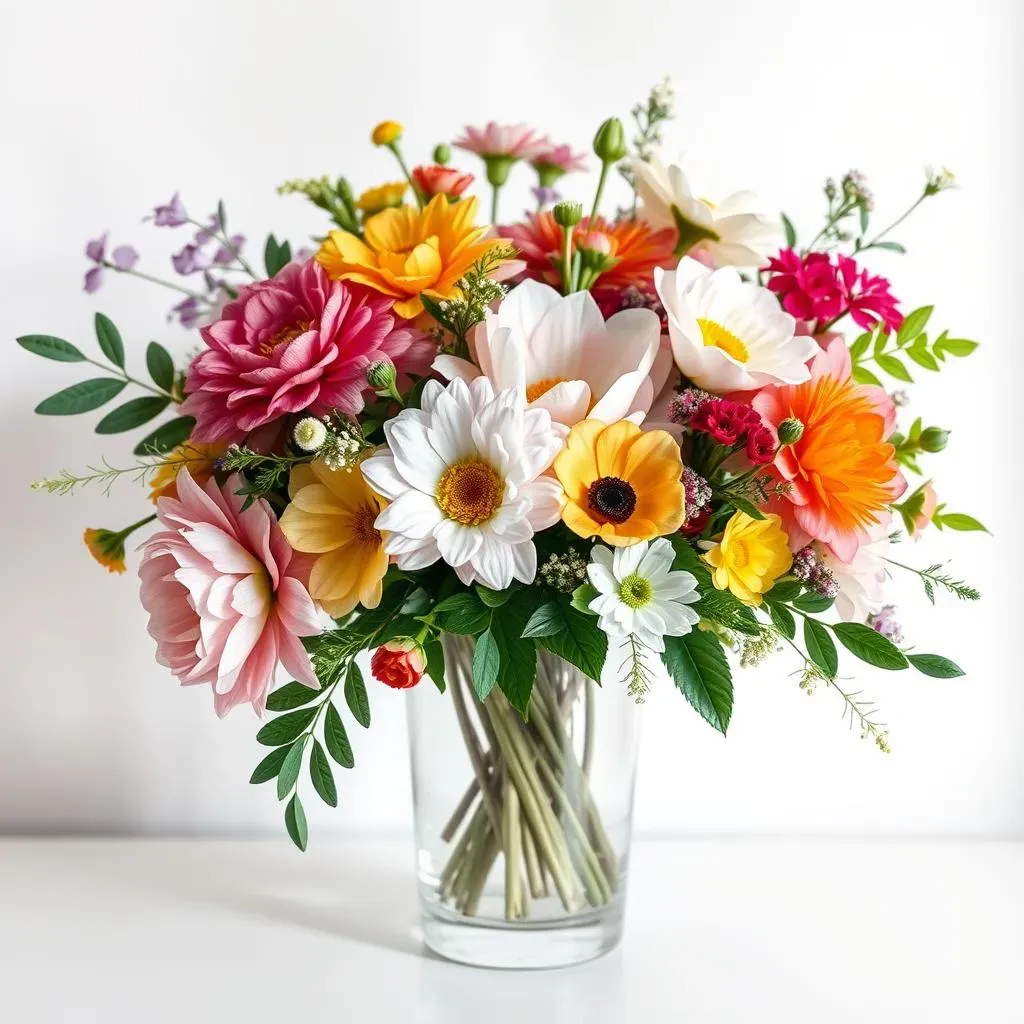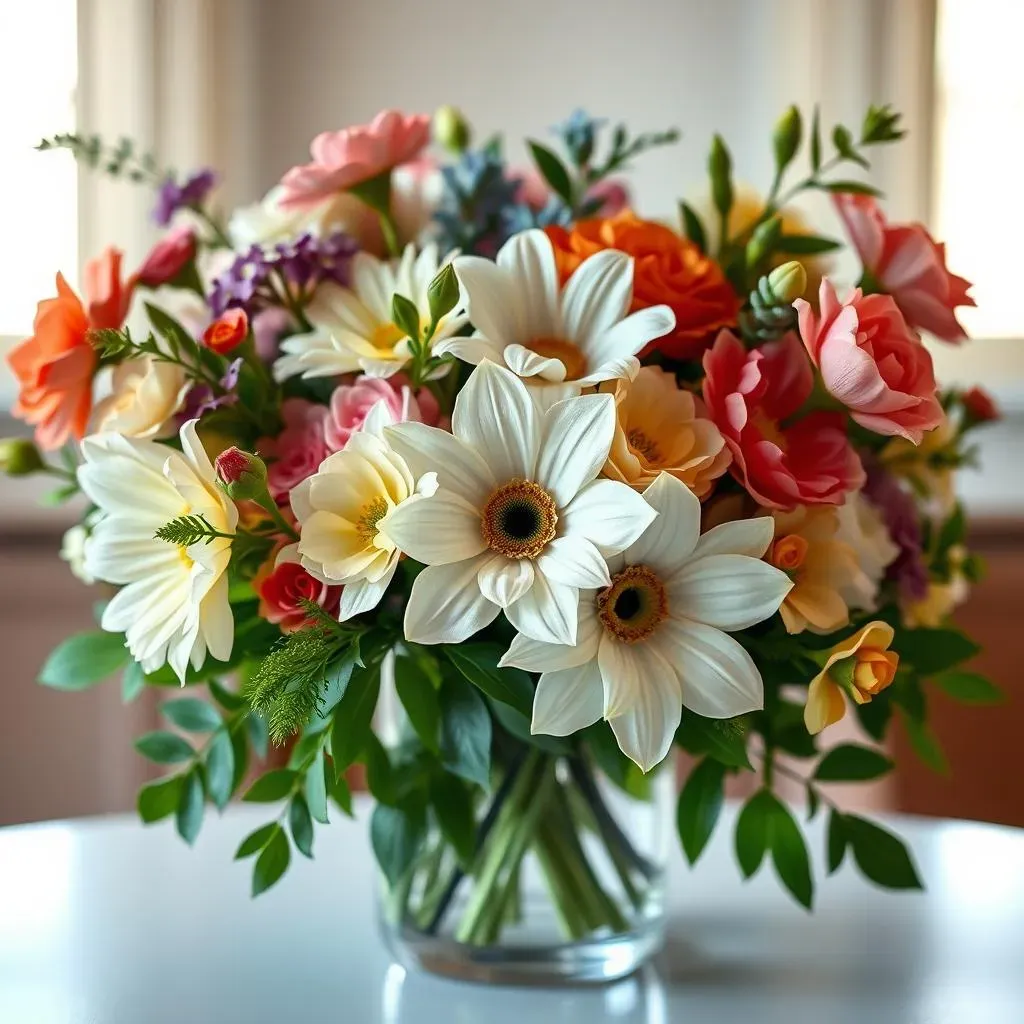Table of Contents
Have you always admired beautiful flower arrangements but felt intimidated by the thought of creating one yourself? Fear not, aspiring floral artists! This comprehensive guide on step-by-step artificial flower arranging for beginners will transform you from a hesitant novice into a confident creator of stunning, long-lasting floral displays. Forget the wilting worries and messy cleanup associated with fresh flowers; artificial blooms offer endless possibilities for creativity without the fuss. We’ll walk you through every step, from selecting the perfect artificial flowers and greenery to mastering the art of arrangement and adding those final, flourish-inducing touches. Whether you're aiming for a simple centerpiece or a more elaborate bouquet, this guide provides clear, easy-to-follow instructions and expert tips to help you achieve breathtaking results. Get ready to unleash your inner florist and create beautiful arrangements that will brighten any space for years to come. Let's dive into the delightful world of artificial flower arranging!
Choosing Your Artificial Flowers and Supplies for StepbyStep Artificial Flower Arranging
Choosing Your Artificial Flowers and Supplies for StepbyStep Artificial Flower Arranging
Selecting Your Artificial Flowers: Quality and Variety
Choosing the right artificial flowers is the cornerstone of a successful arrangement. Don't just grab the first bunch you see! Look for flowers with realistic details – lifelike petals, natural veining, and subtle color variations. Avoid those that look overly plastic or have a uniform, unnatural sheen. Consider the overall style you're aiming for – a romantic, rustic, modern, or perhaps a whimsical feel. This will guide your flower choices. Think about color palettes, too. Do you want a monochromatic scheme with various shades of one color, or a vibrant mix of contrasting hues? The possibilities are endless!
Remember, variety is key! Don't just select one type of flower; mix it up with different sizes, shapes, and textures. Think about incorporating some buds or blossoms that are partially open, adding a sense of movement and dimension. A good mix of flower types adds visual interest and prevents your arrangement from looking flat or repetitive. For instance, combine large, statement blooms with smaller filler flowers and delicate sprigs of greenery.
Flower Type | Quantity | Color | Size |
|---|---|---|---|
Roses | 3 | Burgundy | Large |
Hydrangeas | 2 | Pale Pink | Medium |
Baby's Breath | 1 bunch | White | Small |
Gathering Your Essential Supplies: Everything You'll Need
Beyond the flowers themselves, you'll need a few key supplies to create your masterpiece. First, choose a vase or container that complements your chosen flowers and the overall style of your arrangement. Consider the size and shape – a tall, slender vase might work well for a dramatic display, while a wider, shorter vase is perfect for a more casual look. The material of the vase is also important; glass, ceramic, metal, or even a repurposed container can all work beautifully.
Next, you'll need something to hold your flowers in place. Floral foam is a popular choice; it's easy to work with and provides excellent support for the stems. However, you can also use other materials, such as clay or even pebbles, depending on the size and weight of your flowers and the shape of your container. Finally, don't forget the finishing touches! Consider adding some decorative elements like ribbons, lace, or small figurines to personalize your arrangement and add a touch of your own style.
- Vase or container
- Floral foam (or alternative filler)
- Wire cutters
- Floral tape (optional)
- Greenery (leaves, branches)
- Decorative elements (ribbon, beads, etc.)
StepbyStep Guide: Creating Your First Artificial Flower Arrangement
StepbyStep Guide: Creating Your First Artificial Flower Arrangement
Preparing Your Workspace and Materials
Alright, let's get started! First, find a clean, well-lit workspace. You want enough room to spread out your flowers and supplies without feeling cramped. Gather everything you've collected: your vase, floral foam (or alternative), flowers, greenery, wire cutters, and any decorative elements. Having everything within easy reach makes the process much smoother. Think of it as prepping for a culinary masterpiece – you wouldn't start cooking without all your ingredients ready, would you?
Now, let's prepare your floral foam (if using). If your vase is smaller, you may need to trim the foam to fit snugly inside. Make sure it's securely placed, and if needed, use floral tape to keep it in place. Don’t skip this step! A wobbly foam base leads to a wobbly arrangement – not a good look. Once your foam is secure, you're ready to begin arranging.
Step | Action |
|---|---|
1 | Choose a workspace. |
2 | Gather all materials. |
3 | Prepare floral foam (if using). |
Arranging Your Flowers: Building Your Floral Masterpiece
Start with your focal flowers – these are the largest and most eye-catching blooms. Place these strategically in the center of your foam, ensuring they're at varying heights to add visual interest. Think of it like building a small floral city – you want a variety of heights and positions to create a dynamic and engaging scene. Don't be afraid to experiment with different placements until you find what looks best. Remember, there's no one right way to do this.
Next, add your filler flowers. These smaller blooms help to fill in gaps and create a more lush, full look. Place them around your focal flowers, again varying the heights and angles. Don't be afraid to get creative and play around with the placement. Use your wire cutters to trim the stems as needed to achieve the desired look and ensure everything sits comfortably within your arrangement. You can also use floral tape to secure any particularly stubborn stems.
- Place focal flowers first.
- Add filler flowers to fill gaps.
- Trim stems as needed.
- Use floral tape for extra security.
Adding Greenery and Finishing Touches to Your Artificial Flower Arrangement
Adding Greenery and Finishing Touches to Your Artificial Flower Arrangement
Incorporating Greenery: Adding Depth and Texture
Now for the magic touch – adding greenery! Greenery isn't just about filling space; it adds depth, texture, and visual interest to your arrangement. Think of it as the supporting cast in your floral drama – it enhances the main actors (your flowers) without stealing the spotlight. Choose a variety of greenery types – ferns, eucalyptus, ivy, or even artificial grasses – to create a more natural and realistic look. Vary the sizes and shapes of your greenery, placing some pieces behind your flowers to create a backdrop and others strategically in front to add dimension. Remember, a little goes a long way; you don't want to overwhelm your flowers with too much greenery.
Experiment with different placement techniques. Weave smaller sprigs of greenery between your flowers, tucking them into gaps to create a fuller look. Use larger leaves as a backdrop for your more prominent blooms, or drape longer vines artfully over the edge of your vase for a cascading effect. The key is to create a balance between your flowers and greenery, ensuring that both elements complement each other without competition. Don't be afraid to trim your greenery to fit the overall shape and size of your arrangement.
Greenery Type | Placement Suggestion |
|---|---|
Ferns | Behind larger flowers, filling gaps |
Eucalyptus | Interspersed among blooms |
Ivy | Trailing over the vase edge |
Adding Finishing Touches: Personalizing Your Creation
Once you're happy with the arrangement of your flowers and greenery, it's time to add those finishing touches that will truly make your creation unique. This is where you can inject your personal style and create something truly special. Consider adding decorative elements such as ribbons, beads, lace, or small figurines. These elements can enhance the overall aesthetic and add a touch of personality to your arrangement. For example, a rustic arrangement might benefit from a burlap ribbon, while a modern arrangement might look stunning with sleek metallic accents. Choose elements that complement your color palette and overall style.
Before declaring your masterpiece complete, step back and take a look at your arrangement from all angles. Check for any gaps or areas that need adjusting. Make any necessary tweaks to ensure the arrangement is well-balanced and visually appealing. Then, admire your handiwork! You've successfully created a beautiful artificial flower arrangement that will brighten any space. Remember, practice makes perfect, so don't be discouraged if your first attempt isn't exactly as you envisioned. Keep experimenting and have fun with the process!
- Ribbons
- Beads
- Lace
- Small figurines
- Seasonal accents
Tips and Tricks for Stunning StepbyStep Artificial Flower Arrangements
Tips and Tricks for Stunning StepbyStep Artificial Flower Arrangements
Mastering the Art of Balance and Proportion
Creating a visually appealing arrangement is all about balance and proportion. Think of it like a seesaw – you need to distribute the weight (or in this case, the visual weight of your flowers and greenery) evenly to prevent your arrangement from looking lopsided. Avoid clustering all your flowers in one area; instead, spread them out strategically, creating a sense of harmony and flow. Consider the size and shape of your container; a tall, slender vase might look best with a vertical arrangement, while a wider vase might suit a more rounded, cascading design. Experiment with different placements until you achieve a balance that pleases your eye.
Pay attention to the proportion of your flowers and greenery. You don't want one element to completely overwhelm the other. A good rule of thumb is to use a mix of large, medium, and small elements to create visual interest and depth. Too many small flowers can make your arrangement look busy, while too many large flowers can make it feel unbalanced. Find that sweet spot where all elements work together in perfect harmony. Remember, practice makes perfect; don't be afraid to experiment and adjust until you achieve the desired look.
Element | Proportion Suggestion |
|---|---|
Focal Flowers | 1-3 large blooms |
Filler Flowers | 5-7 medium blooms |
Greenery | Several sprigs/leaves |
Playing with Texture and Color for Visual Appeal
Texture and color are your secret weapons for creating truly stunning artificial flower arrangements. Just like a painter uses different brushstrokes and colors to create a masterpiece, you can use a variety of textures and colors to add depth and visual interest to your floral creations. Don't be afraid to mix and match different textures – smooth petals, fuzzy leaves, spiky branches – to create a dynamic and engaging display. This adds visual complexity and prevents your arrangement from looking flat or monotonous.
Color plays a crucial role as well. Experiment with different color palettes – monochromatic schemes using various shades of a single color, complementary colors that sit opposite each other on the color wheel, or analogous colors that are next to each other. Consider the overall mood you want to create; warm colors like reds and oranges can create a vibrant and energetic feel, while cooler colors like blues and greens can create a calming and serene atmosphere. Remember, color is a powerful tool; use it wisely to create the desired effect.
- Mix smooth and textured elements.
- Experiment with different color palettes.
- Consider the overall mood you want to create.
Embrace Imperfection and Let Your Creativity Shine
"Don't be afraid to break the rules; that's how you find your own style." – Unknown
While there are guidelines and suggestions, artificial flower arranging is ultimately a creative endeavor. Don't be afraid to experiment, break the rules, and let your personality shine through in your arrangements. There's no single "right" way to create a beautiful arrangement; what matters most is that you're happy with the result. Embrace imperfections; they often add character and charm. A slightly asymmetrical arrangement can sometimes look more natural and organic than a perfectly symmetrical one. The most important thing is to have fun and let your creativity flow. Don't be afraid to try new things and find what works best for you.
One of the best things about artificial flower arranging is that you can easily adjust and rearrange your creations without worrying about wilting or damage. Use this to your advantage! Experiment with different flower placements, greenery combinations, and decorative elements until you find an arrangement that truly speaks to you. Remember, there's no such thing as a "mistake" in art; every experiment is a learning opportunity that leads you closer to finding your unique style and creating truly stunning arrangements.
